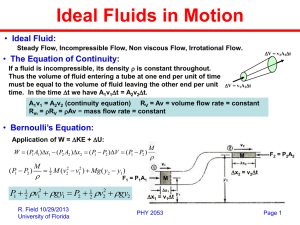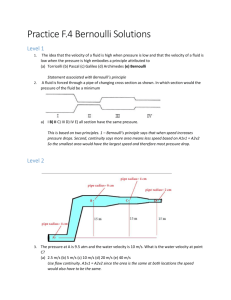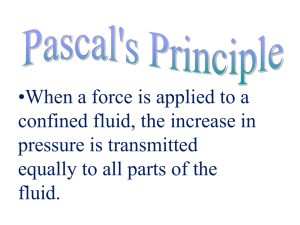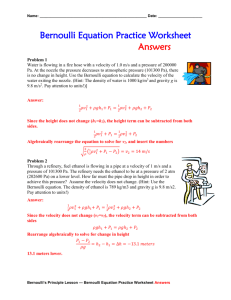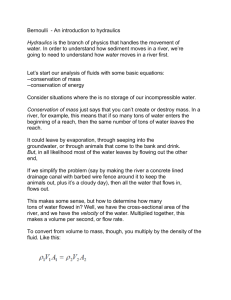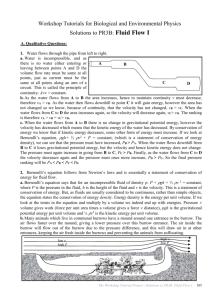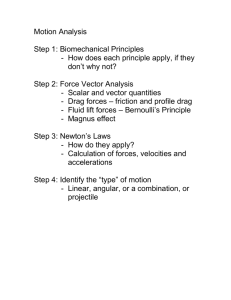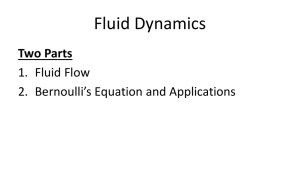Physics II - Moving Fluids
advertisement
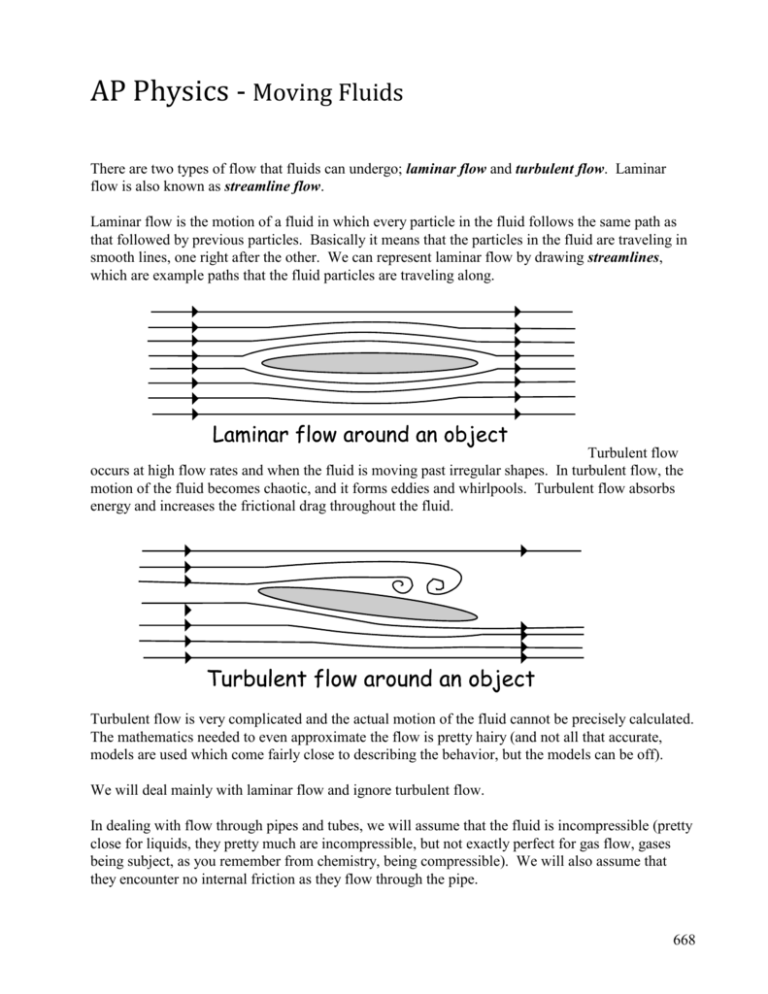
AP Physics - Moving Fluids There are two types of flow that fluids can undergo; laminar flow and turbulent flow. Laminar flow is also known as streamline flow. Laminar flow is the motion of a fluid in which every particle in the fluid follows the same path as that followed by previous particles. Basically it means that the particles in the fluid are traveling in smooth lines, one right after the other. We can represent laminar flow by drawing streamlines, which are example paths that the fluid particles are traveling along. Turbulent flow occurs at high flow rates and when the fluid is moving past irregular shapes. In turbulent flow, the motion of the fluid becomes chaotic, and it forms eddies and whirlpools. Turbulent flow absorbs energy and increases the frictional drag throughout the fluid. Turbulent flow is very complicated and the actual motion of the fluid cannot be precisely calculated. The mathematics needed to even approximate the flow is pretty hairy (and not all that accurate, models are used which come fairly close to describing the behavior, but the models can be off). We will deal mainly with laminar flow and ignore turbulent flow. In dealing with flow through pipes and tubes, we will assume that the fluid is incompressible (pretty close for liquids, they pretty much are incompressible, but not exactly perfect for gas flow, gases being subject, as you remember from chemistry, being compressible). We will also assume that they encounter no internal friction as they flow through the pipe. 668 Rate of Flow: The rate of flow is defined as the volume of fluid that passes a certain crosssection in a given time. In mathematical terms, this rate of flow is: R vA Where R is the flow rate and v is the velocity of the fluid. A is the cross-sectional area of the pipe. Common units for rate of flow are cubic feet per second, cubic meters per second, gallons per second, liters per second, etc. Almost any volume unit and almost any time unit can be used to express flow rate. The flow rate must be a constant throughout the length of the pipe, as we are ignoring friction and assuming that the fluid cannot be compressed. What goes in has got to be what comes out. Imagine water entering a hose at one end, traveling through the hose, and then coming out of the other end of the hose. The water that enters the hose in a given time has to equal the water that leaves the hose in the same time. So R, the flow rate, remains constant no matter what happens inside the hose. A2 v1 A1 v2 The flow rate will be constant even if the radius of the pipe changes. Upstream, the cross-sectional area, A1, is larger than the cross-sectional area downstream, A2. The flow rate at both of these points must be the same. The flow rate is: R vA R v1 A1 v2 A2 so v1 is the velocity of the fluid upstream, v2 is the flow rate downstream, A1 is the upstream cross-sectional area, and A2 is the downstream cross-sectional area. So v1 A1 v2 A2 This is the equation that you’ll get to play with when you take the AP Physics Test. Water flows through a rubber hose 2.0 cm in diameter at a velocity of 4.0 m/s. If the hose is coupled into a hose that has a diameter of 3.5 cm, what is the new speed of the fluid? v1 A1 v2 A2 v1 r12 v2 r2 2 v1r12 v2r2 2 v2 v1r12 r22 669 v2 v1r12 r2 2 m 2.0 cm 4.0 s 3.5 cm 2 2 1.3 m s The Nozzle Effect: When a fluid flows through a narrow opening, a nozzle, its velocity must increase. We can see this in the following problem. Water flows through a rubber hose 3.0 cm in diameter at a velocity of 5.0 m/s. If the hose is coupled into a nozzle that has a diameter of 0.50 cm, what is the new speed of the fluid? v1 A1 v2 A2 v2 v1r12 r2 2 v1 r12 v2 r2 2 m 3.0 cm 5.0 s 0.50 cm 2 v1r12 v2r2 2 180 That’s a pretty good velocity increase! Bernoulli's Principle: A fluid's velocity increases, you have seen, when it flows through a constriction - the diameter of the pipe decreases. To accelerate the fluid as it goes into the constriction, the pushing force in the large diameter area must be greater than the pushing force in the constriction. v2 2 v1r12 r22 m s y B This is shown in the drawing. We have a horizontal pipe that narrows and then resumes its original diameter. Attached at A, B, and C are small tubes filled with fluid. The height of the liquid in these tubes indicates their relative pressures. At A and C the pressure is greater than it is at B. If y is the difference in height between the liquid columns, then the pressure difference is given by: A C PA PB g y This change in pressure that takes place in a constriction is called the Venturi effect. The Venturi effect says that pressure changes are accompanied by changes in velocity. In the 1700’s Daniel Bernoulli (1700 – 1782), a Swiss scientist, experimented with water flowing through pipes. He found that the pressure exerted by a liquid on its walls decreased as its velocity increased. He found it to be true for both liquids and gases. Today we call this the Bernoulli principle. In simple form, Bernoulli's principle says this: 670 When the speed of a liquid increases, its internal pressure decreases. This is a consequence of the conservation of energy. Bernoulli developed an equation which relates pressure and velocity in a fluid system which is called Bernoulli's equation. 1 P gy v 2 const. 2 Where const. is some constant, P is the pressure, is the fluid density, y is the height of the fluid, and v is the fluid velocity. The g y term is the potential energy per unit volume of the flowing fluid. The 1 2 v is the kinetic energy per unit volume of the flowing fluid. 2 We can analyze the flow of a fluid through a system using this equation. P1 v1 P2 y 1 v2 y 2 If we look at two locations in the system, we know that the sum of the pressure, kinetic energy, and potential energy have to equal a constant, i.e., they have to be the same, so we can write: 1 1 P1 gy1 v12 P2 gy2 v22 2 2 Water flows through a pipe that has a constriction in it as shown. P1 v1 y P2 v2 y 671 1 1 P1 gy1 v12 P2 gy2 v22 2 2 Analyzing the terms in Bernoulli’s equation, we see that the potential energy remains the same and cancels out (no change in height, y). Therefore: 1 1 P1 v12 P2 v22 2 2 1 1 P2 P1 v12 v22 2 2 1 P1 v12 v22 2 The initial velocity is smaller than the final velocity, so P2 has to be less than P1. Let’s use Bernoulli’s equation to examine a static system. An oddly shaped tank is filled with water to a depth of 1.20 m. Use Bernoulli’s equation to calculate the pressure at point B at the bottom of A the tank. 1 1 P1 gy1 v12 P2 gy2 v22 2 2 The system is static, so the fluid has zero velocity. The equation becomes: P1 g y1 P2 g y2 1.20 m Assume the pressure at point A on the surface is zero and that the y value is also zero. The equation becomes: 0 P2 g y2 P2 g y2 B If we chose the downward direction to be negative, we get: P2 g y2 Which is the equation we used before for hydrostatic pressure: P gh P2 g y2 1.0 x 103 kg m 32 m 9.8 2 1.20 m s 672 P2 1.18 x 104 Pa A container of water, diameter 12 cm, has a small opening near the bottom that can be unplugged so that the water can run out. If the top of the tank is open to the atmosphere, what is the exit speed of the water leaving through the hole. The water level is 15 cm above the bottom of the container. The center of the 3.0 diameter hole is 4.0 cm from the bottom. y2 Let’s figure what is going on with the flow out the hole at the bottom. We have the area of the hole A1 and the area of the container A2. The water spurts out of the hole with a speed of v1. The flow of water in the container, which makes the surface level drop is very slow by comparison. So slow that we can say that it is zero. So v2 = 0. The pressure on the top of the surface is the atmospheric pressure. The surface acting on the water at the opening on the bottom is also the atmospheric pressure (actually it is a tiny bit bigger because it is slightly lower, but the difference is insignificant). So we can let the two pressures equal each other. So P1 = P2. A2 P0 = P2 y 15 cm Therefore, Bernouli’s equation, 4.0 cm A1 P0 v1 1 1 P1 gy1 v12 P2 gy2 v22 2 2 Becomes: 1 2 gy1 v12 gy2 This simplifies to: 1 gy1 v12 gy2 2 1 gy1 v12 gy2 2 We solve for the velocity, v1: v12 2 gy2 gy1 v1 2 g y2 y1 We can plug in the data: m v1 2 9.8 2 0.15 m 0.040 m s 1.5 m s 673 Applications of Bernoulli's Principle: The Venturi effect is well illustrated in the classic hose nozzle. Water, if allowed to pour out of the end of a one-inch hose, is not traveling at much of a speed. Attach a nozzle to the thing. The nozzle makes the water squeeze through a very small opening. As it does this, its velocity increases greatly, and the stream shoots out like crazy. Its pressure decreases as it goes through the nozzle. This pressure drop does not immediately make sense, because you know that the stream of water blasting out of the nozzle can put a hurt on stuff you go squirting at. Do not confuse the pressure that a liquid has within it with the pressure it can exert when something interferes with its flow. The pressure within a shooting stream of water is low, but the pressure it can exert on something in its path can be quite large. The force it exerts on things in its path is a result of the kinetic energy it has and its momentum. Bernoulli and Flight: Bernoulli's principle is often used to explain why birds and airplanes can fly. One of the reasons that their flight is possible is because of the shape of their wings and the way that air flows over and under these wings. Birds evolved the proper shape for a wing at least 135 million years ago. Human beings didn't catch on until fairly recently. In the 1880s a British scientist named George Cayley developed the cambered wing. It shared a cross-sectional shape with the wing of birds. It looks like this: Here follows the standard explanation. As the wing passes through the air, the flow rate in front of the wing on the top and bottom has to equal the flow rate at the end of the wing on the top and bottom. The air passing over the top of the wing has to travel a longer distance than the air passing under the wing. This is because of the curve on the top of the wing (the camber). Since it is covering a longer distance in the same time, the velocity of the air on the top of the wing is greater than the velocity of the air on the bottom of the wing. From Bernoulli's principle, we know that the pressure decreases as the velocity increases. So the pressure above the wing is lower than the pressure under the wing. Air pressure pushes the wing up to try and equalize the pressures. This upward force is called lift. For something to fly, of course, the lift must be greater than the weight. Birds are engineered to be extremely light in weight. They have hollow bones, no teeth, no bony tail, female birds have only one working ovary, etc. This helps them fly as the amount of lift their wings must develop is very small. The light weight of birds can be deceptive. We think of large birds as being something like 674 a turkey (which, at least for the domesticated ones) do not fly and are therefore quite heavy. But the actual large flying bird is quite different. The Physics Kahuna fondly recalls the wonderful Laysan Albatross (the fabled "gooney bird" of Midway Island). These are large birds - they probably stand 2 - 3 feet tall and have a wingspread of around 8 to 9 feet. On occasion, they would get in the way (like when you were mowing your lawn and you didn't want to run one over). So you'd grab the critter by the neck and tote it to safety. The first time the Physics Kahuna did this, he expected a turkey sized mass for the bird, and applied what he thought was an appropriate amount of force. It wasn't appropriate. The bird ended up being hauled into the sky with a terrific acceleration. The bird was incredibly light. It felt like it was made of a few sticks of balsa wood, some tissue paper, and stuffed with Styrofoam. Other Bernoulli Applications: Another application of the principle includes the chimney. The chimney had a tremendous effect upon the history of Europe. Up till the 10th century, people in many parts of Europe lived in large buildings in a huge room called a great hall. In the winter, a fire would be kept in the center of the room. Everyone - peasants, the nobles, etc. would sleep in the room to keep warm. In the center of the ceiling was a hole that was supposed to allow the smoke to escape. The smoke, of course, did not escape all that well, but would fill the room. Nasty business - breathing smoke is most unpleasant. The chimney changed all that. A chimney is a pipe that extends from the room, through the ceiling, pierces the roof, and then up into the air. The fire is semi-enclosed beneath it. Wind on the outside of the house moves across the roof and across the opening of the chimney. The air in the house at the opening of the chimney is not moving, so there is a pressure difference as a result of Bernoulli's principle. The pressure above the chimney is less, so air is drawn from the room into the chimney and then out the chimney above the house. This carries the smoke to the outside. The chimney is said to "draw". The air does this for two reasons, Bernoulli's principle and the fact that the fire produces hot air which, being less dense, is buoyed upward. Bernoulli's principle is responsible for making sure that none of the smoke leaks into the room. Some of the heat is lost in this way, but enough radiates into the room to keep it warm. After the invention of the chimney, houses were broken up into individual rooms, which was practical with the chimney. The nobles removed themselves from the peasants – kicked them out. Who wants to have a bunch of peasants lying about! Eventually the nobles built their own separate houses. The peasants were left to get by on their own, they ended up living in small, mean, little huts. The rest is history. Other animals, besides birds, have made use of Bernoulli's principle. Prairie dogs build their burrows with multiple entrances. One of the entrances is always higher than the others. The wind near the ground is usually less than it is above the ground. The entrance that is higher than the others usually has more wind blowing over it. This makes the pressure above this opening less. Because of this, air is drawn into the other openings and comes out of the high one. This gives the little critters a sort of natural air conditioning. 675 Baseball pitchers and tennis players also make use of Bernoulli's principle. The curve ball is a pitch that actually does curve. When the ball is released, it is given a spin. As it travels through the air, one side of the ball is going in the same direction as the air. So the ball's spin adds to the air velocity. On the other side of the ball, the spin is in the opposite direction of the air motion So the air is traveling slower on this side of the ball. The pressure is lower on the side with the highest air speed, so the ball is pushed to that side by air pressure; therefore curving. Tennis players learn the technique of giving the ball a spin when they serve. This causes the ball to curve in the same way a curve ball curves -- makes it harder to return. Houses have had their roofs ripped off when strong winds passed over the roofs, creating very low pressures. Air pressure then pushes the roof up and off. Another example of Bernoulli's principle in action is the 'Bernoulli blower' at the Adventurarium. The device has a big fan that blows a strong stream of air straight up. A ball is then thrown into the air stream. It stays in the stream and is not blown out. How come? Well the velocity in the center of the wind stream is greatest. As the ball moves to the outside, one side is in the strong air stream in the center and the other side is in air that is moving slower. The pressure in the center is less because the air is moving faster, so the ball is pushed to the center by air pressure and stays in the stream. 676
